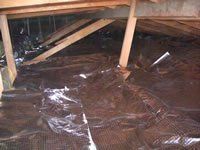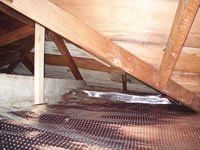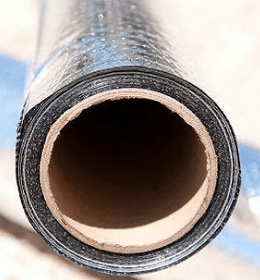Radiant Barrier
- HOW DOES IT WORK?
- WHAT ABOUT INSULATION?
- QUESTIONS & ANSWERS


List of Services
-
When the radiant barrier is installed on the bottom of the attic, can plywood then be placed over the top of it for storage purposes and still retain its insulation effectiveness? Only if you put furring strips or spacers on top to keep at least a quarter of an inch of air space to allow heat to stay in a radiant wave in order to reflect. Heat travels in a wave and it turns into conduction heat when air space is taken away. Hence the insulation in your home slowly conducting heat into your home! My personal advice is put the storage in a storage bin outside in order to insure 100% reflectivity in your home. Your bills and your comfort level will appreciate it!
List Item 1 -
Once the radiant barrier is installed what if i need to later install electrical wiring or lighting to the ceiling below? This is one of the major benefits of Reflective Insulation. It is a two-sided blanket and non-toxic so electricians love this product due to it is safe and harmless, all anyone needs to do is bend down, pull it over, do the work and then pull it back in place. We do not staple or tack or tape it due to its natural weight. It overlaps about 1-2 inches. We only use aluminum tape when we wrap your ducts.
List Item 2 -
Can you walk on top of the material? Will there be any indication where one can walk without stepping through the insulation? We roll the product over your attic floor and we wave it so you have a distinct visual of where the beams are to walk on. This is much more visible to anyone in your attic due to normal mineral insulation can hide the beams. You can walk on it forever and never harm it. It is very durable, remember, this is the same product that is used by the fire departments to protect firefighters from fires, and it is in all the first aid kits. If any gets torn for any reason, your warranty states you receive that sectional piece delivered to you at no charge!
List Item 3 -
Will the install price also include the underside of the garage which gets quite hot during the summer? Garage ceiling is not included in normal pricing since it generally takes the good part of a whole day to do the garage since they have to be on ladders and staple it to the top. If you spend any time in the garage it is a huge benefit!
List Item 4 -
The exterior walls of my home have insulation. What impact does this have on my loss of energy? Is this insignificant compared to the loss through the ceiling? Walls account for 11% energy loss compared to over 80% for ceilings. We feel like we lose more through the walls than we actually do, due to the fact that we live closer to the walls than we do the attic. The true test to prove this is hang out in the attic for a full day and then hang out next to a wall for a full day and you will know that ceiling is where the majority of the problem is in any building environment!
-
What is the "R" value of radiant barrier insulation? The "R" value depends on the number and size of the airspaces surrounding the Radiant Barrier Insulation and on the direction of the heat flow. Since Radiant Barrier Insulation is usually installed on top of the existing mass insulation, its R-value is a moot point. It is Radiant Barrier Insulation's ability to reflect heat that makes it such an energy saver.
-
How does radiant barrier insulation keep me warmer in the winter? Just like wrapping a baked potato in aluminum foil keeps a potato warm longer by holding the heat in, covering your attic insulation with Radiant Barrier Insulation holds the heat in the house. Another analogy would be that Radiant Barrier Insulation in the winter works just like a space blanket, which, although very thin and lightweight, holds your body heat in. A thin space blanket can keep you warmer than several heavy blankets.




